| Article ID | Journal | Published Year | Pages | File Type |
|---|---|---|---|---|
| 6848332 | Research in Developmental Disabilities | 2016 | 8 Pages |
Abstract
Hippotherapy is often carried out for the rehabilitation of children with Cerebral Palsy (CP), with the horse riding at a walking pace. This study aimed to explore the immediate effects of a hippotherapy protocol using a walk-trot pace on spatio-temporal gait parameters and muscle tone in children with Bilateral Spastic CP (BS-CP). Ten children diagnosed with BS-CP and 10 healthy aged-matched children (reference group) took part in this study. The children with BS-CP underwent two sessions of hippotherapy for one week of washout between them. Two protocols (lasting 30Â min) were applied on separate days: Protocol 1: the horse's pace was a walking pace; and Protocol 2: the horse's pace was a walk-trot pace. Children from the reference group were not subjected to treatment. A wireless inertial measurement unit measured gait spatio-temporal parameters before and after each session. The Modified Ashworth Scale was applied for muscle tone measurement of hip adductors. The participants underwent the gait assessment on a path with surface irregularities (ecological context). The comparisons between BS-CP and the reference group found differences in all spatio-temporal parameters, except for gait velocity. Within-group analysis of children with BS-CP showed that the swing phase did not change after the walk pace and after the walk-trot pace. The percentage of rolling phase and double support improved after the walk-trot. The spasticity of the hip adductors was significantly reduced as an immediate result of both protocols, but this decrease was more evident after the walk-trot. The walk-trot protocol is feasible and is able to induce an immediate effect that improves the gait spatio-temporal parameters and the hip adductors spasticity.
Related Topics
Life Sciences
Neuroscience
Behavioral Neuroscience
Authors
Fabiane Nunes Antunes, Alexandre Severo do Pinho, Ana Francisca Rozin Kleiner, Ana Paula Salazar, Giovana Duarte Eltz, Alcyr Alves de Oliveira Junior, Fernanda Cechetti, Manuela Galli, Aline Souza Pagnussat,
